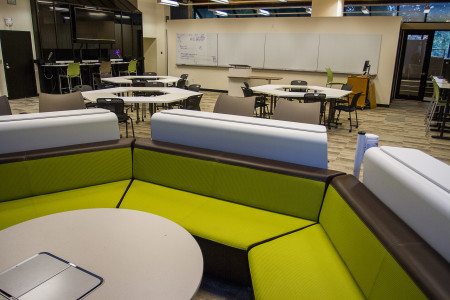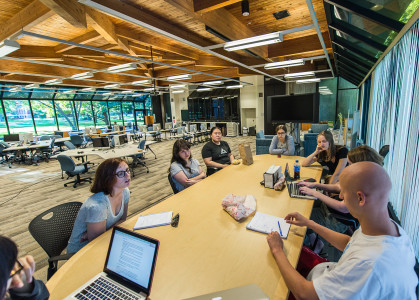

JACK O’MALLEY
omalleyj17@grinnell.edu
Grinnellians may have noticed some changes happening in the former Creative Computing Lab (CCL), located in the Forum. These changes include an almost complete redesign of the space along with a name change. The area now goes by the title Digital Liberal Arts Lab, or “D-Lab” for short.
Much like the CCL, this space is designed to be used by students and professors alike. Besides the name change, a good deal of new technology has also been brought in.
“We’ve added a system call Extron ShareLink which allows for pretty much any device (laptop computer, desktop computer, iPhone, android or tablet) to project wirelessly to the 80” LCDs,” wrote John Hammond, sssistant director of User Services with Information Technology Service (ITS), in an email to The S&B. “This is a very powerful system that we are excited to experiment with in the D-Lab.”
The addition of the ShareLink system will make it easier for students to work on collaborative projects and will allow for more a more creative classroom experience for classes that could potentially be held in the D-Lab.
Along with the new ShareLink system are three Macs and three PC desktop computers, all of which are fully loaded with the programs to which the school has license. Although there was a reduction in the number of desktops as compared to the former CCL, there are now two laptop carts with 20 Macs and 20 PCs for students to use. Along with the more standard pieces of technology, a 3D printer has been added to the space.
“We’ve added a MakerBot 3D Printer,” Hammond wrote. “Materials for the MakerBot can be picked up from the Services Desk or Academic Technology Group whose offices are in the D-Lab.”
This printer is brand new and, as of yet, has not been used by students. However, Hammond said there is a great potential for both classroom and student use. There will also be a non-3D printer and scanner in the space soon.
Part of the reason for the changes to the space is the formation of the Digital Liberal Arts Collective. This group is centered around an effort to combine newer technology with the study of the liberal arts.
“We represent a large investment in terms of money, resources and priorities in thinking about creative ways in which professors and students can infuse technology-rich resources into their scholarship,” said Rachel Schnepper, associate director for Academic Technology.
This program is entirely new this year and there are plans for more expansion in the future.
Not all of these changes, however, have been well-received by students. Much of the complaints center around a reduction in available space.
“They took away half the space and turned it into offices,” said Jack Dunnington ‘16.
Offices now take up a little under half of the space that the CCL used to occupy. These offices are used by the Digital Liberal Arts Collective.
The space has also seen the removal of the large tables with desktop computers on them and replaced them with circular tables which can be rearranged. While this may be preferable for group work, it’s not as conducive to individual study.
“It seems like they are really trying to change the way students use the space instead of listening to what students used the space for,” Dunnington said. “A lot of the work people used to do in the CCL was individual.”
Despite these complaints, the D-Lab and the Digital Liberal Arts Collective hope that the space will be heavily utilized throughout the school year.
“We put a lot of work into the space,” Schnepper said.


















































